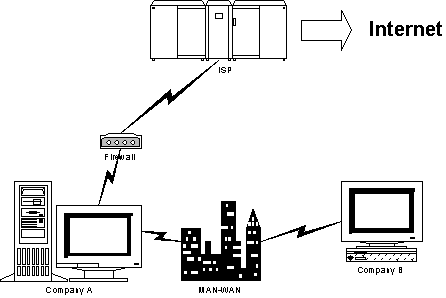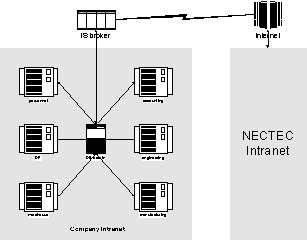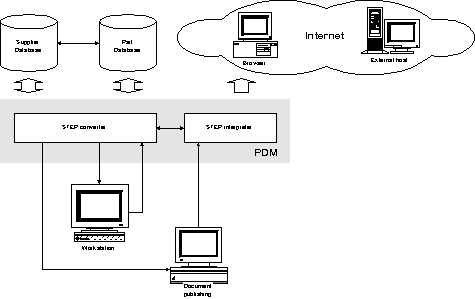
Figure 1. Network Architecture
AbstractFrom Henry Ford's Production Line paradigm to today's Just-In-Time Material Requirements Planning, manufacturing process has undergone theoretical and practical improvement that brought about numerous modernization breakthroughs. Unfortunately, the rising costs of production impede the application of various technological innovation such as robotics from its full potential. This setback instigates yet another radical make over that forever changes the philosophy of modern manufacturing process--distributed manufacturing. As globalization became flourishing during the past few years by means of Information Technology, the notion of distributed manufacturing was elevated to a new realm of orientation, the so called Virtual Manufacturing. No manufacturer possesses all the ultimate technologies necessary to accomplish their business objectives. Not only each specialization is too costly to acquire, but also is impossible to sustain the technological edge for any period of time. This paper addresses some of the principles and issues envisioned by research endeavor concerning the amalgamation of Information Technology and production process that could become a new paradigm of manufacturing technology in Thailand. |
Since the inception of the MATIC Project in 1994, the notion of computerized manufacturing network among participating countries has materialized in the forms of Electronic Yellow Pages, integrated electronic assembly manuals, part information archive, etc. The ultimate objectives, set forth by the MATIC Working Groups, will serve as the cooperative efforts toward member countries’ manufacturing foundation, thus forming a pool of invaluable working resources for the region and global manufacturing community.
As an active member of the MATIC Automotive (WG1) and Electronics (WG2) groups, Thailand has prepared herself to meet the formidable challenge of achieving those objectives. National Electronics and Computer Technology Center (NECTEC) represents the country in carrying out the mission. By collaborating with leading research laboratories and institutions in the country, NECTEC has served not only as the hub linking the country's R&D resources, but also as the mainstay of development effort to fulfill the goals. This white paper describes major areas of endeavor currently under way at NECTEC which will furnish necessary technologies for the success of the MATIC Project and Manufacturing Automation in Thailand.
Powerful as it is, the openness of the Internet creates security concerns that, in spite of efforts and counter-measures to inhibit intruders, many organizations refrain themselves from this omnibus electronic medium so as to preserve their proprietary resources. One promising technology introduced recently, however, is the Intranet [12] which offers solutions to corporate information connectivity. Attempts have been made to establish paradigms for business computing; one such undertaking is known as the DOMINO effect [6]. Its scalability and interoperability lend itself to explosion of business applications. Various forms of workgroup environments such as Lotus Notes [8] have been deployed to improve business productivity.
Realizing the potential of this Intranet, NECTEC, in particular the Computer Technology Laboratory (CTL), is undertaking an in-depth investigation into the issue. A hybrid Internet-Intranet networks, henceforth hybrid-net, is the current theme of our research endeavor. One of the main goals is to utilize the Intranet for participating companies in Thailand and, at the same time, to be able to link up with the Internet community. In so doing, individual firm not only can enjoy the powerful information management tools within the organization without fear of information loss or intrusion, but also can reach out to the global pools of information for exchange, look up, research, and acquire knowledge essential for the application and management of company’s operations.

In this Figure, each organization employs its own Intranet network by connecting existing internal LAN and stand alone computer systems together, forming one huge Intranet loop. These local heterogeneous Intranet loops, each of which belongs to either private or public organizations, are then connected together via communication links, forming a hybrid network distribution that spans the country. The links among organizations can be either private or public, depending upon predetermined arrangement. There are a number of Internet Service Providers (ISP) in Thailand who furnish various forms of networking services, ranging from personal text-based service to corporate GUI-based. NECTEC, the country's main ISP, will be responsible for the introduction and implementation of Intranet utilization. Those enterprise Intranet loops that link up with NECTEC eventually get hooked up to the existing Internet, enabling exterior communication with other countries. Such a configuration offers corporates the benefit of both internal and external connectivity without sacrifying security measure. On the one hand, the Intranet serves as a fire wall that prevents malicious intruders from infiltrating enterprise information systems. On the other hand, connectivity with external networks can be established effortlessly through tightly controlled gateways since the Intranet itself operates on the same protocol as the Internet. Figure 2 illustrates a simple Intranet-Internet configuration.

Based upon this topology, the Intranet links organizations' resources located in different regions, forming an internal MAN/WAN-like connectivity. Any external communication from the Internet to local organizations must pass through the Intranet firewall prior to reaching the destination.
The prime objective of introducing this Intranet technology is intra-communication capability that unifies existing heterogeneous platforms into organization-wide networking. Such a transparent configuration entails information independence that yields numerous potential benefits for many manufacturers who will participate in WG1 and WG2 activities. Examples of omnibus commercial opportunities can be drawn from the Intranet reports [5]. The conceptual design that will be employed to build this hybrid-net is a culmination of many Intranet methodologies, ranging from concepts and rationale [13], intraconnectivity [9] considerations, and subsystem architecture [14]. Details on how information system is setup, operated, administered, and applied are elucidated in the remaining paragraphs of this Section.

In this configuration, each department maintains its own database on existing LAN. Access and retrieval of information by applications on the LAN is inherently straightforward. In spite of numerous available LAN technologies that offer solutions to departmental connection, difficulties arise when non-homogeneous data are acquired from departments residing on geographically disperse LANs. These cross-department, distributed heterogeneous information systems pose great challenges to intra-organization information management. One of a well-established solutions is client-server architecture. As described in concepts and rationale [13], the shortcomings of client-server architecture make the solution unattractive. A variation of client-server, in the form of Universal Client, empowers the individual to create, utilize, distribute, inquire, and maintain an internal effectiveness framework for organization.
A conceptual framework that will be employed in NECTEC's Intranet system is depicted in Figure 4.

Two databases to be set up at NECTEC, namely, material and part database, and supplier database, will serve as sources of information infrastructure. Data stored in both databases filter through a Product Data Management (PDM) layer which will then be converted to STEP (Standard for Exchange of Product Model Data) format for subsequent applications on work stations or document publishing systems. The output is passed on to an interpreter module suitable for browsing. A specialized VRML browser is under construction to facilitate not only viewing of objects in 3-D, but also manipulating and rendering of engineering drawings so as to permit assembly simulation and other engineering analyses interactively. This framework entails heterogeneous platforms to interoperate by means of STEP standard. Thus, users will be able to view engineering artifacts without having to acquire expensive hardware and software.
The access mechanisms of the proposed framework utilize conventional client-server information management scheme in the form of user/author/broker/publisher [13] having browser-server [2] capability. The main objectives are
Numerous efforts have been set out to enable the amalgamation and interoperability of various technologies, standards, and systems which will coexist in a heterogeneous environment. One emerging framework stemming from manufacturing community is the Standard for Exchange of Product Model Data (STEP). The prime objective is to provide a standardized platform for myriad of engineering data interchange formats. As such, tool specific idiosyncrasies can be rectified by employing STEP format. Exchange of engineering data from a design platform to a different analysis environment can easily be accomplished without loss of information.
One advantage of having the STEP standard to aid in design information exchange is simplicity of prototyping, in particular, Rapid Prototyping (RP). The notion of RP has emerged as an effective and economical tool for manufacturing community with numerous applications, both in academic and commercial [10] areas. Prototypes can thus be created on any environment and transferred to target platform in a straightforward manner.
Among the many manufacturing automation activities currently under way at NECTEC is the establishment of a Rapid Product Development (RPD) program. The basic philosophy of RPD was realized from the advent of Intranet and Intelligent Manufacturing Systems (IMS). It is envisioned that such integration will result in a wide array of automated manufacturing applications in Thailand.
The following paragraphs describe some research endeavors in the areas of IMS and RPD.
To achieve versatile, dynamic, state-of-the-art technology, and most important of all, rapid delivery of product, existing manufacturing process must undergo a make over not only from the technology standpoint, but also the management of technology itself, the so-called Intelligent Manufacturing Systems (IMS). Kawamura [7] has proposed a manufacturing village in which shared methodologies and tools are norm for advanced manufacturing. IMS International [3], an internationally organized body, aims at exploring, adapting, and integrating tools and techniques in strategic deployment of these technologies. The Rapid Product Development [4] Test Case Program was conducted to accelerate the development of new products and improving their quality. In order to support similar R&D endeavor of domestic IMS program at NECTEC, the hybrid-net will be employed to exploit the potential of technology deployment. The concepts of tele-manufacturing [1] in the forms of teleconferencing among disperse design teams, interactive design and assembly of parts on work stations, or remote simulation can be exercised over the hybrid-net. As a consequence, cooperation on geographically disperse workgroups or multi-national facilities can be cost-effectively distributed, hence a virtual enterprise.
The ideas of Electronic Manual and Electronic Yellow Pages that precipitated from cooperative efforts of the WG1 and WG2, respectively, coincide with our vision on Product Data Management (PDM) development initiative. The principal of PDM applications are reusability of standard components and modular assembly for engineering design and fabrication process. Such a scheme enables not only less effort on re-inventing the wheel, but also shorter development cycle in order to furnish timely delivery of product to consumer. New ideas can be formulated and transformed into products by means of integrated technological innovation. The result of this unique environment helps shorten "time to market" which is a long range plan of Rapid Product Development Center (RPDC) at NECTEC.
A number of research efforts are under way to incorporate this RPDC into actual manufacturing process cycle. One prominent research work in the area has been the Rapid Product Development Network [15] of the Fraunhofer Institute. Peripheral research efforts such as Virtual Reality [18] will undoubtedly enhance the "look and feel" of the RPD and Assembly [16] process. The WG2 will also pursue the issue on perfecting its Electronic Yellow Pages research in order to support interoperability among member countries. The underlying framework must support hierarchical heterogeneous platforms akin to open architecture. The primary database search mechanism will take the form of either conventional navigator or expert systems equipped with domain knowledge of lower level databases that distribute over the MATIC Network. As such, queries originated from anywhere in the network will be carried out by this search engine. This extra layer not only facilitates ease of information look up, but also makes the entire system transparent to users.
Other works that will be undertaken at NECTEC to support globalized virtual manufacturing and automation are application of STEP tools for networking assembly and public PDM.